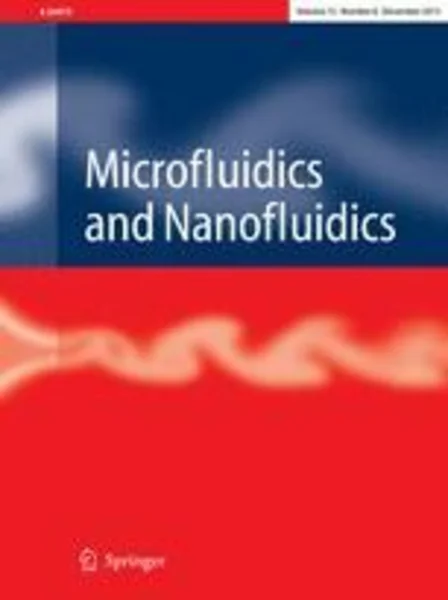-
wetting considerations in capillary rise and imbibition in closed square tubes and open rectangular cross-section channels
جزئیات بیشتر مقاله- تاریخ ارائه: 1392/07/24
- تاریخ انتشار در تی پی بین: 1392/07/24
- تعداد بازدید: 1037
- تعداد پرسش و پاسخ ها: 0
- شماره تماس دبیرخانه رویداد: -
the spontaneous capillary-driven filling of microchannels is important for a wide range of applications. these channels are often rectangular in cross-section, can be closed or open, and horizontal or vertically orientated. in this work, we develop the theory for capillary imbibition and rise in channels of rectangular cross-section, taking into account rigidified and non-rigidified boundary conditions for the liquid–air interfaces and the effects of surface topography assuming wenzel or cassie-baxter states. we provide simple interpolation formulae for the viscous friction associated with flow through rectangular cross-section channels as a function of aspect ratio. we derive a dimensionless cross-over time, t c, below which the exact numerical solution can be approximated by the bousanquet solution and above which by the visco-gravitational solution. for capillary rise heights significantly below the equilibrium height, this cross-over time is t c ≈ (3x e/2)2/3 and has an associated dimensionless cross-over rise height x c ≈ (3x e/2)1/3, where x e = 1/g is the dimensionless equilibrium rise height and g is a dimensionless form of the acceleration due to gravity. we also show from wetting considerations that for rectangular channels, fingers of a wetting liquid can be expected to imbibe in advance of the main meniscus along the corners of the channel walls. we test the theory via capillary rise experiments using polydimethylsiloxane oils of viscosity 96.0, 48.0, 19.2 and 4.8 mpa s within a range of closed square tubes and open rectangular cross-section channels with su-8 walls. we show that the capillary rise heights can be fitted using the exact numerical solution and that these are similar to fits using the analytical visco-gravitational solution. the viscous friction contribution was found to be slightly higher than predicted by theory assuming a non-rigidified liquid–air boundary, but far below that for a rigidified boundary, which was recently reported for imbibition into horizontally mounted open microchannels. in these experiments we also observed fingers of liquid spreading along the internal edges of the channels in advance of the main body of liquid consistent with wetting expectations. we briefly discuss the implications of these observations for the design of microfluidic systems.
مقالات جدیدترین رویدادها
-
استفاده از تحلیل اهمیت-عملکرد در ارائه الگوی مدیریت خلاقیت سازمانی و ارائه راهکار جهت بهبود
-
بررسی تاثیر ارزش وجوه نقد مازاد بر ساختار سرمایه شرکت های پذیرفته شده در بورس اوراق بهادار تهران
-
بررسی تأثیر سطح افشای ریسک بر قرارداد بدهی شرکت های پذیرفته شده در بورس اوراق بهادار تهران
-
بررسی تأثیر رتبه بندی اعتباری مبتنی بر مدل امتیاز بازار نوظهور بر نقد شوندگی سهام با تأکید بر خصوصی سازی شرکت ها
-
تأثیر آمیخته بازاریابی پوشاک ایرانی بر تصویر ذهنی مشتری پوشاک ایرانی (هاکوپیان)
-
بررسی پایداری انبارداری قیر اصلاح شده با پلیمر ترکیبی پلی بوتادین را بر ضایعاتی و اتیلن ونیل استات ضایعاتی
-
تحلیل عددی پدیده تحکیم غیرخطی لایه رس اشباع با شرایط زهکشی متغیر نسبت به زمان
-
analytic description and explicit parametrisation of the equilibrium shapes of elastic rings and tubes under uniform hydrostatic pressure
-
pillared montmorillonite supported ferric oxalate as heterogeneous photo-fenton catalyst for degradation of amoxicillin
-
inverse radiation analysis in an absorbing, emitting and non-gray participating medium
مقالات جدیدترین ژورنال ها
-
مدیریت و بررسی افسردگی دانش آموزان دختر مقطع متوسطه دوم در دروان کرونا در شهرستان دزفول
-
مدیریت و بررسی خرد سیاسی در اندیشه ی فردوسی در ادب ایران
-
واکاوی و مدیریت توصیفی قلمدان(جاکلیدی)ضریح در موزه آستان قدس رضوی
-
بررسی تاثیر خلاقیت، دانش و انگیزه کارکنان بر پیشنهادات نوآورانه کارکنان ( مورد مطالعه: هتل های 3 و 4 ستاره استان کرمان)
-
بررسی تاثیر کیفیت سیستم های اطلاعاتی بر تصمیم گیری موفق در شرکتهای تولیدی استان اصفهان (مورد مطالعه: مدیران شرکتهای تولیدی استان اصفهان)
-
مرور سیستماتیک ادبیات کاربست فرهنگ مربیگری هم راستا با فرهنگ سازمانی
-
جایگاه حقوقی ابزارهاى جایگزین اوراق قرضه در قانون ایران
-
تأثیر مهارت های مدیران مدارس ابتدایی بر کیفیت عملکردی
-
طراحی و تولید مجموعه دادگان اخبار فارسی ihu-persiannewsdataset-javadzade-et-al دانشگاه جامع امام حسین
-
modeling of the solar thermal energy use in urban areas




سوال خود را در مورد این مقاله مطرح نمایید :